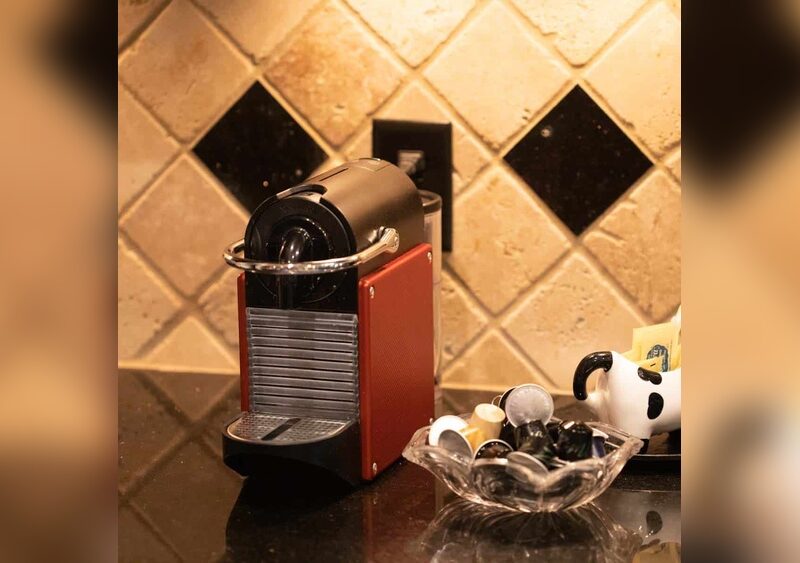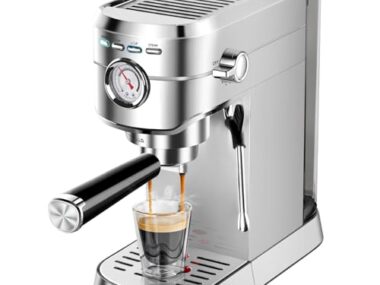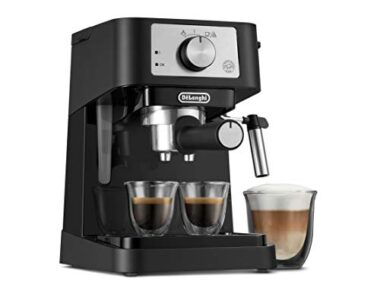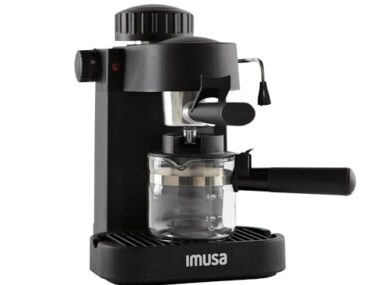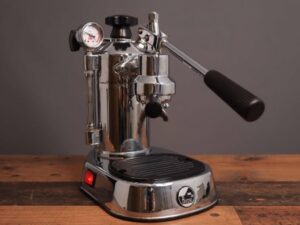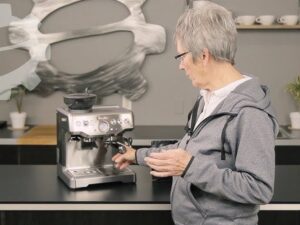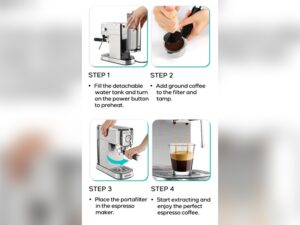Are you wondering if an espresso machine costs less than a Nespresso? Choosing the right coffee maker can save you money and improve your daily coffee routine.
You might think a fancy espresso machine is expensive, but is it really pricier than the popular Nespresso pods? Keep reading to find out which option fits your budget and lifestyle better. This simple comparison will help you make a smart choice for your perfect cup of coffee every morning.
Initial Investment Costs
Understanding the initial costs of espresso and Nespresso machines helps in making smart choices. This section breaks down the price ranges of both machines. It shows what you pay upfront before enjoying your coffee.
Espresso Machine Price Range
Espresso machines vary widely in price. Basic models start around $100. Mid-range options typically cost between $300 and $700. High-end espresso machines can go beyond $1,000. These machines often offer more features and better build quality. Buying an espresso machine means investing more upfront. You pay for the machine and sometimes accessories like grinders and tampers.
Nespresso Machine Price Range
Nespresso machines usually cost less at the start. Entry-level models begin near $100. Mid-range machines often fall between $150 and $300. Premium versions may reach $500. Nespresso machines focus on convenience and speed. The price includes the machine and capsules you buy regularly. Initial investment is lower than many espresso machines. This appeals to those who want quick coffee without extra tools.
Ongoing Expense Comparison
Choosing between an espresso machine and a Nespresso machine means thinking about ongoing costs. The initial price is just one part. You also pay for coffee, cleaning, and maintenance. These costs add up over time. Understanding them helps you pick the best option for your budget.
Cost Of Coffee Beans Vs. Capsules
Espresso machines use coffee beans that you grind yourself. Buying beans in bulk often costs less per cup. You can choose cheaper or premium beans. This gives more control over price and taste.
Nespresso machines use capsules. Each capsule has a fixed price. Capsules cost more per cup than beans. The price stays steady, but it can be high in the long run. You pay for convenience and consistent flavor.
Maintenance And Cleaning Costs
Espresso machines need regular cleaning and occasional repairs. Cleaning tools and descaling solutions add to costs. Some parts wear out and need replacement. These expenses vary by machine type and use.
Nespresso machines require less cleaning. You still need to descale sometimes. The machines are simpler to maintain. Repair costs can be lower but depend on the model. Overall, maintenance is usually cheaper than for espresso machines.
Energy Consumption And Efficiency
Energy consumption plays a big role in deciding which coffee maker is cheaper over time. Both espresso machines and Nespresso machines use electricity differently. Understanding their power use helps save money on bills and reduces waste.
Efficiency also matters. Machines that heat water fast and use less electricity during standby or brewing are better for your wallet. Let’s explore how much power each type of machine uses daily and monthly.
Power Usage Of Espresso Machines
Espresso machines usually use between 1000 and 1500 watts while brewing. The heating element needs energy to reach high temperatures quickly. Brewing a shot takes about 25 to 30 seconds.
Some espresso machines stay on for long periods, using extra power in standby mode. Others have an auto-off feature to save energy. Using these features can lower electricity costs.
Manual espresso machines may use less power overall because you control the brewing time. Automatic machines can use more electricity if they run longer or have extra functions like steam wands.
Power Usage Of Nespresso Machines
Nespresso machines typically use 1200 watts during brewing. The machines heat water quickly to make coffee in less than a minute. This fast process can save energy compared to longer brewing times.
Most Nespresso machines have an energy-saving mode. They switch off automatically after a few minutes of inactivity. This feature reduces power use when not in use.
The single-serve design means only the needed amount of water is heated. This limits wasted energy and makes Nespresso machines quite efficient for small coffee servings.

Credit: www.nytimes.com
Convenience And Time Factors
Convenience and time are key when choosing between an espresso machine and a Nespresso machine. Both devices offer unique benefits but differ greatly in how much effort and time they require. Understanding these factors helps decide which fits better into your daily routine.
Preparation Time For Espresso Machines
Espresso machines need more steps. You grind the beans, measure, and tamp the coffee. Then, you wait for the machine to heat up. Pulling the perfect shot takes around 3 to 5 minutes. Cleaning the portafilter and steam wand adds extra time.
This process suits those who enjoy hands-on coffee making. The effort can be rewarding but is not quick. Mornings with little time may find this slow.
Preparation Time For Nespresso Machines
Nespresso machines work fast and simply. Insert a coffee capsule, press a button, and the machine brews automatically. Heat-up time is usually under a minute. A cup of coffee is ready in about 30 seconds.
Cleaning is easy since capsules are disposable. This makes Nespresso machines ideal for quick coffee and minimal cleanup. Perfect for busy mornings or office use.
Durability And Lifespan
Durability and lifespan are key factors when choosing between an espresso machine and a Nespresso. Both machines serve coffee lovers but differ in build and longevity. Understanding their lifespan helps decide which offers better value for money.
Average Lifespan Of Espresso Machines
Espresso machines typically last between 7 to 10 years. Their durable parts and metal bodies handle daily use well. Regular maintenance like cleaning and descaling extends their life. High-end machines can even last over a decade. Proper care prevents common issues like leaks or pressure loss.
Average Lifespan Of Nespresso Machines
Nespresso machines usually last around 3 to 5 years. They have many plastic components that wear faster. Frequent use and water quality affect their durability. Cleaning capsules and descaling regularly helps maintain performance. After this period, repairs may become costly or parts unavailable.
Environmental Impact And Cost
Choosing between an espresso machine and a Nespresso affects both the environment and your wallet. Each option has its own impact on waste and resource use. Understanding these factors helps make a better choice for the planet and your budget.
Waste Produced By Capsules
Nespresso machines use coffee capsules that create plastic and aluminum waste. These capsules often end up in landfills, taking years to break down. Some brands offer recycling programs, but they are not available everywhere. Espresso machines use ground coffee, which produces less waste overall. Coffee grounds can be composted, reducing environmental harm. Choosing an espresso machine lowers the amount of non-biodegradable waste.
Sustainability Of Coffee Beans
Coffee beans for espresso can come from sustainable farms. Many brands label their coffee as organic or fair trade. This means better care for the environment and workers. Nespresso also offers some sustainable coffee lines, but options are limited. Buying whole beans for espresso allows more control over sourcing. This choice supports eco-friendly farming practices more easily than capsules do.
Hidden Costs To Consider
Choosing between an espresso machine and a Nespresso involves more than just the price tag. Hidden costs can affect the overall expense and satisfaction. These costs often surprise buyers after the initial purchase. Understanding these expenses helps make a better choice.
Accessories And Upgrades
Espresso machines often need extra accessories. Items like grinders, tampers, and milk frothers add to the cost. Some machines require special water filters or cleaning kits. Upgrading parts for better performance also costs money. Nespresso machines usually need fewer extras. You mainly buy capsules, which can be costly over time.
Warranty And Repairs
Espresso machines can have higher repair costs. They have more parts that can break or wear out. Some repairs need a technician, which adds to expenses. Warranty periods vary and may not cover all problems. Nespresso machines have simpler designs. Repairs might be cheaper or replaced under warranty more easily.

Credit: www.youtube.com
Which Option Offers Better Value?
Choosing between an espresso machine and a Nespresso can be tricky. Both have upfront costs and ongoing expenses. Understanding which offers better value helps you decide wisely. Let’s explore the cost per cup and long-term financial benefits of each option.
Cost Per Cup Analysis
Espresso machines use ground coffee or pods, depending on the model. Ground coffee usually costs less per cup than Nespresso pods. A typical espresso shot with ground coffee costs about $0.30 to $0.50.
Nespresso pods, on the other hand, usually cost between $0.70 and $1.00 each. This makes the per-cup price higher than making espresso from ground coffee. The convenience of pods comes at a premium.
Espresso machines require coffee beans or grounds, which are cheaper in bulk. Nespresso pods come pre-packaged and sealed, adding to their price. The cost difference grows with frequent coffee drinkers.
Long-term Financial Benefits
Espresso machines often have a higher initial price. Some models can cost hundreds of dollars. Over time, the cheaper coffee grounds reduce the total cost per cup.
Nespresso machines tend to cost less upfront. But the pods add up over time. For daily coffee drinkers, these costs can become significant.
Espresso machines also allow more flexibility in coffee choice. You can buy beans or grounds on sale. This can save money over the long term.
Nespresso offers convenience and quick brewing. This might be worth the extra cost to some users. Consider how much you drink coffee each day before deciding.

Credit: www.nytimes.com
Frequently Asked Questions
Is An Espresso Machine Cheaper Than A Nespresso?
Espresso machines often have higher upfront costs than Nespresso machines. However, espresso machines offer cheaper long-term coffee expenses. Nespresso machines use pods, which are pricier per cup. Over time, espresso machines can save money if you buy beans in bulk.
How Do Maintenance Costs Compare For Both Machines?
Espresso machines require regular cleaning and occasional repairs, which can add costs. Nespresso machines need minimal maintenance, mainly descaling. Pod machines generally have lower upkeep costs. However, espresso machines can last longer if maintained properly, balancing maintenance expenses over time.
Which Machine Offers Better Coffee Value For Money?
Espresso machines provide more control over coffee strength and flavor, enhancing value. Nespresso offers convenience but limits customization. The value depends on your coffee preferences and usage frequency. For daily coffee lovers, an espresso machine may offer better long-term value.
Are Coffee Pods More Expensive Than Espresso Beans?
Yes, coffee pods typically cost more per cup than espresso beans. Pods come pre-packaged and convenient but have a premium price. Buying espresso beans in bulk lowers cost. Choosing beans allows more variety and savings compared to pods.
Conclusion
Espresso machines often cost more upfront than Nespresso machines. But they can save money over time if you drink coffee daily. Nespresso machines offer convenience and quick brewing. They also have a higher cost per cup. Espresso machines need more effort but give more control.
Your choice depends on budget and how you like coffee. Both options have their own value. Think about what matters most to you before deciding.
